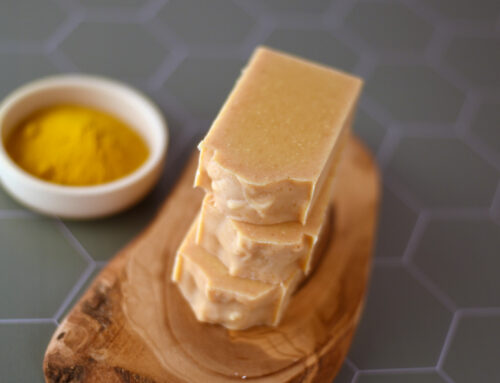Sometimes you want the benefits of oats in your soap without the scratch. Even ground oats can be quite exfoliating. You can use colloidal oatmeal, or if you want, you can make oat milk!
I like making oat milk as a vegan alternative to goat milk. So instead of goat milk and honey soap, you can make oat milk and agave soap for your vegan customers. 🙂
Making DIY Oat Milk For Handmade Soap
You will need:
- Oats
- Distilled Water
- 16 oz. Jar
- Cheese Cloth
To make oat milk simply grind old fashioned or steel cut (not instant) oats in grinder or food processor. Put 1/4 cup into a 16 oz. mason jar. Top off with distilled water. You can use more or less oats depending on what you are going for.
If you want your oat milk thicker, then use 1 cup oats (before grinding) to 3 cups water.
I usually let it sit out for an hour or two, stirring occasionally. And then I put it into the fridge overnight to use the next day. Give it a shake every now and then.
Once you’re ready to soap, strain it. I just top my jar with some cheese cloth and rubber band and pour it into another container.
Now we’re left with a wonderful oat milk ready to soap! You can use the oat milk in any recipe. Simply replace the water with the oat milk.
Happy Soaping!
-Amanda Gail










good recipe
It Sounds good,
I will also try this.
Sounds good,
I will also try this.
Faço muitas vezes sabão com leites vegetais- aveia,arroz, alpista-100g de cereal/1000ml de água. Quando faço o sabão uso no alcalino em substituição da água mas na concentração de 30% NaOH/70% leite vegetal .
Adicino a soda no leite à temperatura ambiente e deixo esfriar. Faço o sabão à temperatura ambiente abaixo dos 15° pois o trace é bem rápido.
Thanks for the simple tutorial, Amanda :). I am having some issues using it though :(. I made the “thick” or more concentrated version and tried adding my lye to my combo of water and oat milk. I instantly got serious yellow lumps…gross! I tried a second time, this time while working in an ice bath thinking it was the heat reaction with the oat milk. Awful yellow lumps again, they just took a touch bit longer before they developed. Since I had all the oils ready to go, I quick did a search for more info/help. It seems it is generally recommended that oat milk be added after you reach light trace, so the third time I tried that. Things went much better, but eventually, my soap did develop the weird lumps. I noticed it on the top of the batch not long after I poured it into the mold. Then when I unmold and cut it, I could see the bars had the lumps all throughout and just look weird. Do you have success not freezing and adding your lye right to it? Am I missing something? I did have some of the ground oats left in the milk because I wanted to still incorporate some “colloidal” oatmeal in the bar. This has not caused problems before though, as I’ve added ground oats to another batch. I would love to hear more specifics on how to use oat milk successfully :). I will probably not make the thick version again though, that will be my next test! 🙂
Hi Amanda, when I mixed the lye with the oat milk it got semi thick is this suppose to happen? Also I usually soap with my oils and lye solution with temperatures at 130 with this mixture should I soap at a lower temp? Also I’m a CPOP soaper would the oat milk work with this process or only for cold process soaping?
How to keep the properties of coconut milk if you do not freeze it?
Amanda,
I’ve been using 1 teaspoon of Colloidal Oatmeal per pound of oils, which doesn’t sound like very much to me, compared to other soapers who use 1 tablespoon p p o o. My Coconut milk, honey, and oatmeal bars don’t feel very smooth while curing. I’m going to try this method and use part coconut milk and part oat milk to see if the soap turns out smoother. Thanks for the great article! See you on Saponification Nation! 🙂
Sounds amazing Amanda!!! I cant wait to try.
Can oat oil, oat extract, and oat milk be used interchangeably? I read that oats were good for sensitive skin, extremely dry skin, and damaged (eczema and psoriasis) skin so I bought a lot of oat oil, some oat extract and some colloidal oatmeal. Is oat milk better than oat oil?
Hi, Why is instant not advised?
It just creates a mush that isn’t easily strained. At least that has been my experience. You could give it a go and see how it works for you.
Thank you! That is great to know! Definitely do not want mush! 🙂
Do you have a nice recipe to use this in? Maybe one with oat oil/butter to maximize the goodness?
Hi hi Amanda, does it discolour your soap? What a great idea! Also does it make the bar more creamy/ lathery/ something else? Thanks for all your knowledge-sharing, I’m so grateful.
Fabulous recipe Amanda, thank you!
I hate oat scratchiness! Been doing this for awhile and it works wonderfully.
Thanks, Amanda…do you freeze the oatmilk the same as any other milk before adding to the lye?
I actually didn’t freeze it and it came out okay. I’m going to do another post where I used it. You certainly could freeze it though! 😉
mmmm…I am wondering if it goes darker when you don’t freeze it….i’m going to give it a whirl…some say it feels like silk…:)